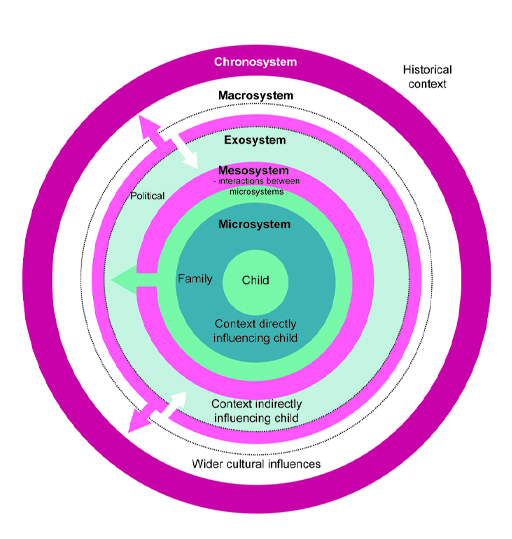4.1 Social ecology
Social workers routinely apply their understanding of human development when assessing need and when providing support to service users. In this process, a social-ecological perspective can help social workers not only to acknowledge the unique developmental paths of individuals, but also can allow for the influences on the development of each individual’s location, their family, community, and social and cultural contexts to be taken into account. This incorporates the impact on individuals of their social ecology, which itself is often subject to independent change, but is not usually subject to the rate and capacity for change of any individual living within that social context.
This perspective underpins many of the frameworks for assessment used by social workers across the UK. For example, as suggested in the Department of Health ‘Assessment Triangle’ shown in section 3(b).2(A).
Brofenbrenner (1979) outlined his social-ecological model (sometimes called a bioecological theory) as having four principal components: proximal process, person characteristics, context, and time. Sometimes abbreviated as PPCT, these four elements are defined as follows:
(a) Proximal processes (influencing development)
Transactions between an individual and the context (both spatial and temporal) in which they are located. Proximal processes are ‘engines of development’ (Bronfenbrenner and Evans, 2000, p. 118) that either directly promote outcomes of competence or diminish the possibility of dysfunctional outcomes. Bronfenbrenner stressed that proximal processes actualise genetic potential and are more likely to do so in stable and advantageous environments and where individuals have strong emotional relationships (Rosa and Tudge, 2013).
(b) Person characteristics (influencing development)
Individual level variables, including temperament, age, gender, abilities and disabilities, play a part in initiating and influencing proximal processes.
(c) Context (influencing development)
This is the best known part of Bronfenbrenner’s theory and originated in the early part of his career. Bronfenbrenner illustrates (see Figure below) how children develop within a number of contextual systems:
- Microsystems – for example, home, school or peer groups – have a big impact on child development.
- Mesosystems are the interactions between the microsystems. For example, how well do school and home communicate with each other?
- Exosystems do not contain the child but are external conditions – for example, the parents’ employment – that may have an impact on parenting. This also relates to specific social policies that may impact on wellbeing and development.
- Macrosystems are the wider economic, social, cultural and political systems, ideologies and conditions within which the child is developing.
Later work (for example, Bronfenbrenner and Morris, 2006) made clear that proximal processes, whether involving solitary interaction with objects or symbols or interaction with one or more other social partners, occur within microsystems, but that the other systems of context are also influential (Rosa and Tudge, 2013, p. 253).
(d) Time (influencing development)
Bronfenbrenner also stressed the importance of time and how development involves both continuity and change (Rosa and Tudge, 2013). Events and experiences both internal (such as entering puberty) and external (birth of a sibling) impact on development. In some cases these are expected (starting school) or unexpected (death of a parent). Bronfenbrenner, influenced by Elder (1974) and the life course perspective, also acknowledged the impact of historical events on development.

